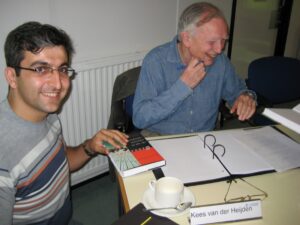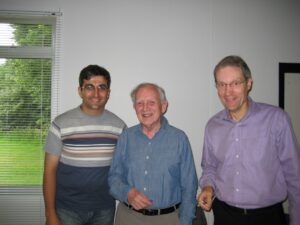I haven’t had time to update my site for several months. But hearing the news of Professor Kees van der Heijden’s death made me write about the things I learned from him and share them with the public on my website.

I was only a few days with the professor at Oxford University and got to know his lessons in 2007. Today, I want to share with others the things that I learned from him that I will never forget. The first thing that Professor van der Heijden taught to all the students and people who were present in his scenario planning class was the difference between prediction, forecasting and scenario thinking. Recognizing the differences and distinguishing between these three concepts is crucial for a successful futurist. The main issue that he emphasized a lot was the existence of uncertainties. He divided the fundamental uncertainties into risks, uncertainties and unknowables. He introduced the scenario as a tool for organizing knowledge and collective wisdom, and he talked about the role of narration and conversation, especially strategic conversation, as very important tool for creating Knowledge. The first issue that he emphasized that we should all pay attention to was the existence of mental models. Because we always imagine all the situations we are in, both individually and organizationally and as a group, in the one particular mental model. He said that a scenario planner should be able to suspend his mind in disbelief and look at and analyze the situation in front of him with several mental models. Each of these mental models was actually the starting point of a scenario.

Of course, before starting any scenario project, he said that scenario planner should asked what is the main goal of this scenario, what is your goal in coming to scenario planning? Have you come to the scenario for a strategic decision? Or do you just want to have a sense and understanding of a phenomenon or a situation? Or do you want to increase your forecasting power or test your strategic goals? He used to say that before starting any scenario project, determine your main goal.
Professor van der Heijden was one of the people who introduced the scenario as a tool for deep interactions and a tool for improving perception, both at the individual and organizational levels. He said that scenarios are actually a tool to create links between phenomena, not to create boundaries between phenomena. He said that the nature of narrative and story-type scenarios in fact establishes a connection between phenomena and gives them an understandable meaning, and he believed that only images and visualizations are not enough for individuals and organizations. Rather, the story-telling power of the members of the group and organization or even the society should be stimulated and they should recount their images in the form of narratives and scenarios so that they can find the links between their mental phenomena and put commonalities in the focus of their attention. Among the authors, he was very interested in the writings of Geoffrey Vickers and the concept of “Appreciative System” to identify how people value a particular subject or phenomenon, as well as the “soft systems methodology” that belonged to Peter Checkland. Because for him, finding the true nature of the problem and identifying it accurately was more important than anything else. He emphasized a lot on the concept of uncertainty and finding structural uncertainties as well as finding theories that can explain the phenomenon in question in different frames.

He referred a lot to the article “The Causal Texture of Organizational Environments” written by Emery and Trist. Professor van der Heijden expressed the scenario in the form of learning processes and studied and mastered most of the theories that were psychological or cognitive science-oriented about learning and was always trying to be able to use these theories to connect them with the scenario thinking about the future. It was highly focused on Vygotsky’s writings on the scaffolding process and the proximal zone of development, and Piaget’s theories of cognitive development and Kolb’s learning styles.
Another concept that was very prominent in the professor’s mind was the subject of mental models. He always emphasized on identifying mental models and challenging dominant mental models in organizations with the help of scenarios. In the end, Professor van der Heijden expressed all these works as a kind of conceptualization of the future. That is, with the help of scenarios, people, individuals and organizations are looking for a creative concept of the future or a part of the future, which is under the shadow of uncertainty and cannot be expressed with existing concepts and the dominant language of the organization’s people. Professor van der Heijden strongly believed in the framing of scenarios as a tool for effective communication and always considered scenario planning as a process of scaffolding ideas in the minds of people in the organization or society.
He always stressed that scenario planning is not about finding answers, but about finding correct and accurate questions, as well as finding new words and concepts that will express the knowledge created in the organization about the future in a holistic picture. Finding these concepts and explaining them in the form of a story is actually the essence of scenario planning projects.
Although I had a brief meeting with him for a few days, I learned a lot of deep things from him, and I will always have the memory of being in the scenario planning class with him in my mind. I wish him divine forgiveness.

 فارسی
فارسی
